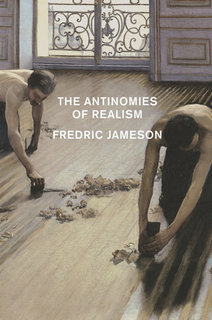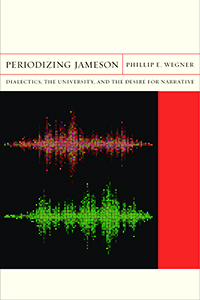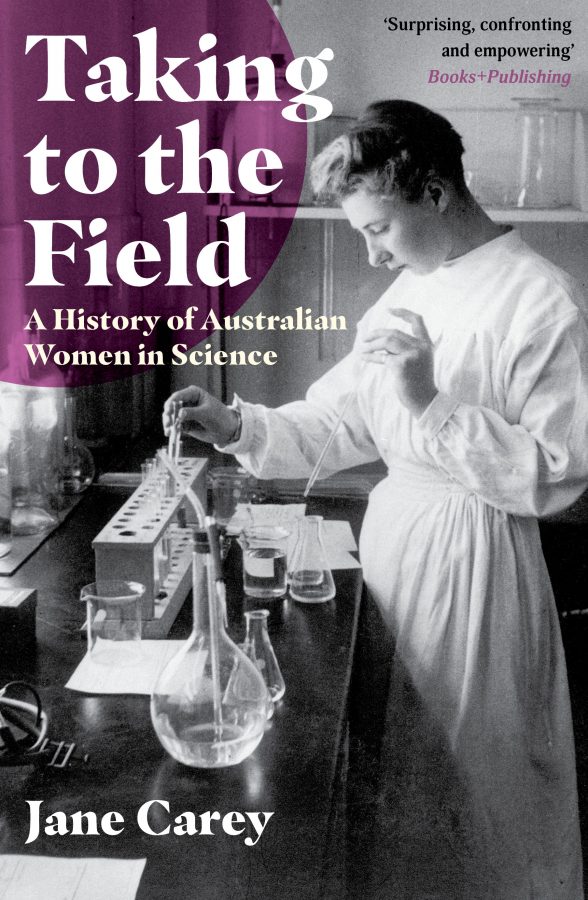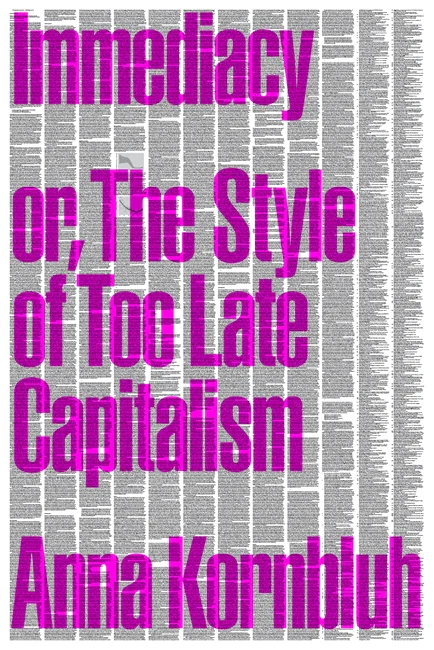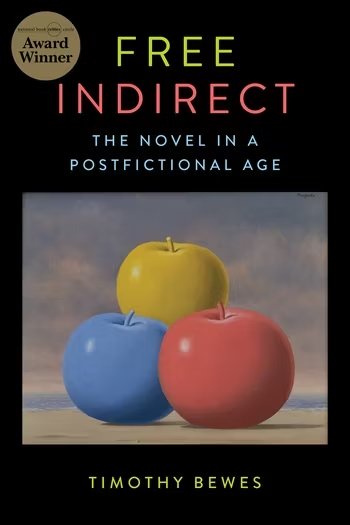As Opposed to What? The Antinomies of Realism & Periodizing Jameson
With The Antinomies of Realism, Fredric Jameson finally provides the sustained examination of literary realism that those following his critical writings have long suspected might one day appear. It is not sufficiently iterated in commentary about this literary theorist best known for his powerful reading of postmodernism as the ‘cultural logic of late capitalism’ that the concept of realism has always been an essential part of the scaffolding in his critical architecture. Yet Jameson has not until now devoted an entire book to what he calls a ‘hybrid’ literary mode.
In Jameson’s many previous books, realism was always in the shadows. It was an essential minor player, or a supporting antagonist, or even part of the back-stage crew, but never the central character; it was never directly under the glare of his formidable critical spotlight. This was true in the case of realism’s relationship to romance in The Political Unconscious: Narrative as a Socially Symbolic Act (1981); its relationship to modernism in A Singular Modernity: An Essay on the Ontology of the Present (2002); and its role as ‘an absent third term’ (the second being modernism) in Postmodernism, or, The Cultural Logic of Late Capitalism (1991). As long ago as 1974, in a review of J. P. Stern’s On Realism, Jameson prepared us for his approach:
various realisms take on their essential characteristics in determinate opposition to some other movement, so that a ‘realism’ which confronts classicism will be fundamentally different from one opposed to romanticism, and both from the one Lukács distinguishes from naturalism, and so forth.
It is a point that he makes again early in this new work: ‘Realism, for or against: but as opposed to what?’
Fredric Jameson is a literature Professor at Duke University and a preeminent contemporary theorist with catholic interests. Literature, art, architecture, film and popular culture are among the many ‘social forms’ broached in his often daunting, erudite, cross-referenced critical corpus. With this new book, he turns his critical attention specifically to literary realism, and the results are fascinating. The Antinomies of Realism comprises two parts, the first of which is also titled ‘The Antinomies of Realism’ and consists of an expansive new argument about the foundations necessary for the emergence of literary realism. The second part, ‘The Logic of the Material’, collects two previously published essays and one new essay, which concludes the book, drawing together arguments made in the preceding sections and presenting Jameson’s thoughts about the future of realism. The book as a whole complements his previous work on modernism and postmodernism; indeed, Antinomies is the third volume (written out of sequence) of a monumental six-volume project, The Poetics of Social Forms, of which there is ‘an overview, confirmed by Jameson’, in the final chapter of Philip Wegner’s Periodizing Jameson: Dialectics, the University, and the Desire for Narrative.
That literary realism is the focus here is an important point. For as much as Jameson’s writing has relied on and occasionally argued with realism, it has not always been literary realism under interrogation. This is something that Jameson acknowledges early on about contemporary critical approaches to realism: ‘later discussions of [the] term tend to be contaminated by those of the visual arts’. The point applies to Jameson himself. Before this book, his most sustained analysis was the ‘Experience of Italy’ essay in Signatures of the Visible (1990) and that was a discussion largely about film. ‘The Experience of Italy’ is a key antecedent to The Antimonies of Realism. It is certainly the place in which Jameson presents, as he states in his introduction to Signatures of the Visible, ‘the most sustained rehearsal of the dialectic of realism, modernism and postmodernism … so far attempted’.
There are also a number of more recent essays that, with hindsight, prepare the ground on which he now treads – including, oddly enough (and for reasons I will return to), his recent writing on William Gibson and cyberpunk. Essays on realism and utopia in Kim Stanley Robinson’s Mars trilogy (Antinomies is dedicated to Robinson) and David Simon’s HBO series The Wire clearly inform the book. As does Jameson’s essay about providence in nineteenth-century realism for Franco Moretti’s monumental collection The Novel (which is included here), and his afterword to the excellent collection Adventures in Realism (2007), edited by Matthew Beaumont (which is not included, but from which key passages are nevertheless extracted).
And what a surprise this book is. After a series of connected works – Valences of the Dialectic (2008), The Hegel Variations (2010) and Representing Capital (2011) – which have consolidated rather than expanded his conceptual apparatus, The Antinomies of Realism advances new arguments about realism that should encourage further productive critical investigations. Perhaps the most valuable aspect for Jameson scholars is the way that this new work manages to provide an original reading of literary realism, which is not only valuable in its own right, but useful in the way it moves the spotlight onto a topic that was, until now, relegated to a supporting role in his writing. It is testimony to the breadth of Jameson’s scholarship that The Antinomies of Realism also expands our understanding of his analyses of those other phenomena (modernism, postmodernism), which constitute his monumental contribution to cultural and literary theory.
Jameson aims ‘to come at realism dialectically’ and he demonstrates again that he is one of the great contemporary dialectical thinkers. The Antinomies of Realism contains many surprising and enlightening passages: on the importance of competing temporalities; on the difference between emotion and affect; on the significance of Émile Zola’s naturalism (by an passionate exegetist of Georg Lukács!); on the renewal of historical realism by Hilary Mantel and David Mitchell (by a wary critic of E. L. Doctorow!). Perhaps most significantly, Jameson insists that aesthetic realism is best thought of as a process.
An inevitable consequence of such breadth is, however, the ‘curious development’ which Jameson identifies in the introduction: that ‘wobble’ when ‘we attempt to hold the phenomenon of realism firmly in our mind’s eye’. While the point of the book is not to provide a final, neat answer to the question ‘what is literary realism?’ (suffice to say that dialectical thinking does not provide final answers), one does sometimes long for guidance in such a wide-ranging discussion, as to the definition of the term ‘realism’ and how it is being deployed. What is it, specifically, that this word ‘realism’ names? The ability to name is after all one of literary theory’s – and literature’s – great strengths.
Yet giving something a name also encases it in amber; it freezes it in a time and a place and starts the reification process. And it turns out that this is partly Jameson’s point. He encourages us not to look for definitions, or to accept realism as a fixed style, or as the deployment of descriptive skill. Rather, there are, he insists, two sources for literary realism that are outside language. One source is temporal, the other is bodily, and they are both unstable. It is not for nothing that the book is entitled The Antinomies of Realism, or that Jameson announces his dialectical intensions early: at every point the positive term used to advance an argument is broken down into constituent antinomies.
Jameson argues, first, that realism is a consequence of the tension between the past-present-future chronology of inherited tales and the eternal present of consciousness. Jean-Paul Sartre’s distinction, borrowed from Ramon Fernandez, between ‘the récit and the roman’ – the tale and the novel (Jameson prefers the French) – is vital here. Sartre famously dismissed the stories of Guy de Maupassant as merely anecdotal, experiential storytelling and upheld the authentic novel (roman), based on the ‘eternal present’ of existential choices. But Jameson is not so much interested in authentic existential novels as he is in the idea of linking the ‘eternal present’ to the novel in a way that emphasises – in the idiom of Henry James – showing rather than telling. Against this, the pre-novelistic récit, which emphasises telling, is a necessarily past-tense form that nevertheless retains an inbuilt futurity, a past-present-future chronology, and what Jameson will ultimately call ‘destiny’. He posits that one source for the emergence of realism is when this ‘destiny’, implicit in the traditional anecdote, is constrained by the ‘eternal present’ of the pure narrative scene.
The second source or impulse Jameson claims for realism – affect – is the more surprising of the two. It is also the one that informs much of the subsequent literary analysis. Realism does not emerge alongside the evocation of familiar names (for things, for emotions), but together with a sensory perception that must be connected with the body and not merely the intellect. He makes the point by distinguishing between named emotions and affects – ‘if the positive characteristic of the emotion is to be named, the positive content of an affect is to activate the body’ – and insists that realism is an affective fiction:
by positing the named emotion (rather that emotion tout court) as the binary opposite of affect per se (or at least the term whose difference allows us best to articulate the latter’s identity), I am also insisting on the resistance of affect to language, and thereby on the new representational tasks it poses poets and novelists in the effort somehow to seize its fleeting essence and to force its recognition.
This means that, crucially, for realism to emerge the scene must not only be eternal, in the sense discussed above, but nameless. Perhaps the best way of succinctly grasping Jameson’s complex idea here is to hold it in counterpoint (as Jameson himself does at one point) to the New Critics’ concept of the ‘pathetic fallacy’, wherein the background details of a particular scene are dressed with the emotion of the character (famously, the storm on the heath in King Lear demonstrating Lear’s inner turmoil). The pathetic fallacy, Jameson writes, ‘takes as its object emotion rather than affect’. What makes a writer’s use of nature or the weather in this manner seem so unacceptable is the pre-existing circulation of meaning, which we use to ‘read’ and reject the realism. This is precisely not affect, which cannot be intellectually or emotionally parsed, but which instead stirs a nameless bodily response – a response which, at certain points in the book, the term ‘melancholy’ is best able to evoke, though this does come dangerously close to giving Jameson’s nameless affect a name.
Another name, though not for the affect itself, is naturalism. Though it would be a mistake to conflate Jameson’s argument with naturalism tout court, it is fair to say that what we commonly recognise as literary naturalism is the aesthetic form that manifests many of the qualities his argument stresses. This is something Jameson acknowledges, in what is likely to be the most surprising admission for long-time readers of his work, with its acknowledged debt to Lukács. Naturalism, he writes, is ‘the fundamental form of novelistic realism’.
Of course, it does not end there. Jameson’s dialectical method kicks in and he acknowledges that once ‘names’ arrive, we are no longer dealing with realism as he sees it:
the name, whatever its vocabulary field – the celebration of the body or the positing of something like melancholy as the fundamental ground-tone of human existence – necessarily turns the affect into a new thing in its own right.
And so the process continues, most obviously with modernism. Has any literary critic since Georg Lukács and Erich Auerbach given us such a complex place from which to start?
Careful explication of these temporal and affective framing coordinates occurs in the first few chapters of The Antinomies of Realism. Once this is done, Jameson explores the various ‘features and potentialities’ that his approach opens up, which in their turn complicate matters further. Leo Tolstoy, Bénito Perez Galdós – whose frequent absence from any list of great nineteenth-century realists is said to be ‘more than a crime’ – and George Eliot are among those whose works are treated to close readings. The cross-cutting between characters in Tolstoy, the dominance of minor characters in Galdós, the problem of evil in Eliot: all are evidence of, and add complexity to, the temporalities and the affect with which Jameson began.
But the novel will not be reduced to a formula. It is, Jameson observes, ‘an omnibus form cobbled together out of heterogeneous materials’. All the works discussed display evidence of both conformity and rebellion, and Jameson insists that realism contains its own dissolution.
Granting such time and energy to working through these ideas about the affect of realism is surprising for a theorist who just ten years ago described the mode as ‘exhausted’ and as ‘a trick and a deceit’. His previous ambivalence is perhaps not surprising, however, when one considers the great twentieth-century turn against literary realism. After the modernist break, writing that reminded certain critics of the nineteenth-century mode was often seen as an attempt to ‘naturalise’ or ‘normalise’ a resolutely bourgeois ideology and was rejected on those grounds. The modern world was far too complex to depict realistically in a single work of literature, so the argument went, and attempting as much implicitly suggested there was no way ‘out’ of what must inevitably be a partisan view of reality.
Realism for Theodor Adorno meant tacitly supporting the status quo and turning suffering into entertainment. Roland Barthes and his fellow structuralists argued that realist cultural products simplify contingent historical complexity and, in doing so, make the course of history seem ‘natural’ and ‘inevitable’. Later poststructuralists, such as Jacques Derrida, would claim that the mode relied on a false and ultimately authoritarian external (outside the text) authority to validate its normative claims. The French theorist of postmodernism Jean-François Lyotard went so far as to identify a conservative nostalgia in realism that, ironically, may actually veil the world: such nostalgia is, he insisted, designed ‘to preserve … consciousnesses from doubt’.
Jameson has largely abstained from entering such debates. This abstinence can be attributed, at least in part, to his commitment to the critical project begun by Georg Lukács. Back in 1977, reflecting on the famous realism-modernism debate between Lukács and Bertolt Brecht – a primary debate as far as these issues are concerned – Jameson went so far as to ponder whether it was Lukács ‘who has some provisional last word for us today’. Admitting that Lukács’ position on modernist literature was untenable (‘Be like Tolstoy,’ mocked Brecht, ‘but without his weaknesses! Be like Balzac – only up-to-date’), Jameson nevertheless wanted to suggest that once the estranging lessons of modernism – such as Brecht’s V-effect – have been learnt, Lukács’ totalising approach seems newly relevant. Modernist alienation and fragmentation must themselves be estranged. Of course, in the years following, Jameson would develop a ‘totalising’ theory of postmodernism that was better able to explain the current cultural ‘logic’ and to inform an appropriate stance toward contemporary literary aesthetics. He would not look to the writers Lukács praised, but rather build on the rationale behind that praise.
In his recent criticism, Jameson is most sympathetic to science fiction and cyberpunk: ‘the representational apparatus of Science Fiction,’ he argues in a review of William Gibson’s Pattern Recognition (2003), ‘is sending back more reliable information about the contemporary world than an exhausted realism.’ In his seminal book on postmodernism, regretting the absence of a chapter dedicated to the genre, Jameson describes cyberpunk as ‘the supreme literary expression if not of postmodernism, then of late capitalism itself’.
Critics have inferred from stances such as these that William Gibson’s cyberpunk functions for Jameson in a manner approximating Balzac’s realism for Lukács. Now that we have The Antinomies of Realism, however, it is clear that the matter is more complex. Jameson claims in The Seeds of Time (1994) that cyberpunk is a postmodern analogue for nineteenth-century naturalism: ‘[disclosure] to a horrified bourgeois readership’. Readers may now wonder whether he maintains that cyberpunk is a postmodern style, or whether it might be said to evince the pure scene and affect of realism in that 1980s and early-1990s moment of ‘high-postmodernism’.
I mentioned at the outset that there have only been a few critics who have explored Jameson’s interest in realism. Dougal McNeill finds that Jameson’s critical vocabulary, when praising science fiction, ‘arrives soaked in the language of realist aesthetics’. Carolyn Lesjak locates, in that key Jamesonian praxis cognitive mapping, a revitalisation of the privilege that Marxists (even Brecht, in his own way) typically accord literary realism. ‘Cognitive mapping,’ she writes, ‘functions as Jameson’s version of a new realism.’
To these voices we now need to add Phillip E. Wegner, with his excellent new study Periodizing Jameson: Dialectics, the University, and the Desire for Narrative. Wegner is Professor and Marston-Milbauer Eminent Scholar at the University of Florida and long-time student of Jameson (who supervised Wegner’s dissertation at Duke University). Despite Jameson’s later twists and turns, Wegner finds that there is an ‘unqualified fidelity’ to the dialectical tensions of Marxism and Form: Twentieth-Century Dialectical Theories of Literature (1971) – a book that Wegner insists is a ‘realist’ text – in all Jameson’s subsequent work.
When Lukács condemned Zola’s naturalism, he did so because, in his estimation, Zola began with preconceived abstract ideas into which a narrative was then shoehorned. Lukács privileged the work of Balzac, because Balzac allowed narrative tensions to arise from the tale he set in motion. Similarly, for Wegner, Jameson, in Marxism and Form, ‘discovers his object as its story unfolds’. Jameson is beholden to the momentum of tale he wants to tell and to his cast of characters. He is not as immediately concerned with abstract preconceived notions. Marxism and Form can thus be read as a narrative that unfolds in the same way that history itself unfolds: surprisingly and wrenched to and fro by crucial actors and immanent tensions. Its chapters are ‘ordered like those in a realist novel, each figure appearing on stage when, and only when, necessitated by the development of the work’s plot’. And if it also shares, as Wegner writes, the ‘revolutionary energies of an earlier modernism’ – the book examines the work of Adorno, Marcuse and Benjamin, and might be interpreted as part of that last gasp of high modernism, which manifested itself in 1960s critical theory – then this is merely part of the dialectical argument. It is an inaugural step, like literary modernism itself, that must begin with, and come to terms with, if only to break with, normative assumptions about literary realism.
Jameson has written that his periodising schema – realism–modernism–postmodernism – should not just be understood as a historical periodisation, but also dialectically. Wegner takes this injunction to heart and uses the schema – he calls it a ‘fundamental plot device’ – to read Jameson’s language and narrative dialectically. That is, he uses Jameson’s analysis to read ‘Jameson’: in short, Marxism and Form is realist, The Political Unconscious is modernist, and Postmodernism is postmodernist.
Following the inaugural discussion of the ‘realism’ of Marxism and Form, Wegner finds that The Political Unconscious is a ‘cancelled realist text’, available to be read or ‘decoded’ in a number of ‘realist’ ways and in this sense it is ‘modernist’. Then, in Postmodernism,
what disappears … are the narrative rhythms that structured the two earlier texts … even the ‘cancelled realisms’ of The Political Unconscious are no longer evident in a work that moves from object to object and text to text with no discernible narrative logic.
These are for Wegner the first three key Jameson texts, published at ten-year intervals. It is not as simple as that, of course, but that is nevertheless the basic trajectory:
Each of these earlier books marks the conclusion of a distinct period in Jameson’s intellectual development, which … can be productively characterized using his three-fold periodizing schema.
It does not end there. Slavoj Žižek has long insisted that a good dialectician should learn to count to four and, correspondingly, a fourth text, Archaeologies of the Future: The Desire Called Utopia and Other Science Fictions (2005), enters Wegner’s discussion at the mid-way point and plays a pivotal role.
If the antinomies of Lukács’ totalising approach to realism animate Jameson’s critical project, a utopian impulse is central to his dialectical method. In the second half of Periodizing Jameson, the singular importance of Archaeologies of the Future becomes evident. That book’s preoccupation with the utopian impulse in science fiction enters, and productively disrupts, Wegner’s analysis. The modified argument begins in a surprising and yet, for readers of Jameson, entirely consistent way: it challenges the orthodox understanding of semotician and linguist A. J. Greimas’ famous ‘semiotic square’. Wegner argues that if the semiotic square – a key interpretive tool for Jameson – is read in conjunction with Lacan’s tripartite classificatory schema – the Symbolic, the Imaginary and the Real – it becomes an invaluable way to clarify the contradictions of dialectical thinking generally, and Jameson’s thought specifically.
In Wegner’s design, the ‘complex’ axis of Greimas’ square is homologous to the Symbolic order, the ‘middle plane’ to the Imaginary, and the ‘neutral’ axis to the Real. His hypothesis is ‘that the Greimasian schema reconceived in this way offers us a representation of the very movement of dialectical thinking and writing’.
Using his reconfigured square, Wegner is able to ‘draw’ the dialectical method of not only Jameson, but other thinkers such as Michael McKeon, Alain Badiou and Slavoj Žižek. It is clear in all cases that what is drawn on the neutral / Real axis presents the greatest challenge and opportunity. For Jameson’s dialectical method, this is, perhaps most significantly, the ‘utopian impulse’. Which is to say that that the utopian impulse, and the book in which it is most thoroughly analysed, play a specific dialectical role: they are ‘a negation of the negation of postmodernism’:
Postmodernism develops both a symptomology of the present and a figuration of possible forms of the Symbolic of cognitive mapping appropriate to our new global reality. Archaeologies in turn offers a ‘poetics’ of the Real.
Such is the pivotal importance of Archaeologies of the Future – intended as the sixth and final book of Jameson’s Poetics of Social Forms series – in a career devoted to historicising and totalising, a career that began with and remains committed to the challenges suggested by aesthetic realism. Indeed, Wegner makes the connection even more explicit: his analysis of the inevitably realistic depictions and the implicit ‘totalizing thinking processes that take place in utopian and science fictional world making’ links Jameson’s arguments about the utopian impulse to the motivations underlying Lukács’ analysis of realism.
Wegner worries that Archaeologies of the Future, with its still-not-quite-accepted object of study (science fiction / utopian literature), will fall out of favour in a manner similar to Jameson’s earlier ‘under-appreciated’ book on Wyndham Lewis, Fables of Aggression (1979), ‘the only one of Jameson’s books to have been out of print for any extended period’. Periodizing Jameson will go some way, one hopes, to ensuring that that does not happen.
Periodizing Jameson was published just after The Antinomies of Realism, so unfortunately it does not incorporate any significant discussion of Jameson’s new book (though it is mentioned). This is a shame, because in the final chapter of The Antinomies of Realism Jameson brings much of the above analysis together in a single remarkable essay. ‘The Historical Novel Today, Or, Is It Still Possible?’ reads like a summation of Jameson’s intellectual career. One wonders what Wegner would have made of it.
The chapter begins with an argument about, again, names. Whether it is the ‘reduction of world-historical individuals to little more than their names’ or the pastiche of ‘named’ historical periods in period dramas, ‘names’ act in the contemporary historical novel as little more than depthless placeholders for history proper. This is Jameson’s familiar argument about the nostalgic fate of historical fiction in postmodernity, and it is at this point that he has fascinating things to say about Hilary Mantel’s A Place of Greater Safety (1992), which depicts significant figures in the French Revolution, and which he regards as a noteworthy exception.
Against the wider tendencies of historical fiction, Jameson holds up the example of David Mitchell’s Cloud Atlas (2004). Much in the same way that Pierre Bourdieu’s monumental The Rules of Art (1992) rests on William Faulkner’s shoulders, Jameson uses Mitchell’s novel to restate many key arguments made not only in the preceding chapters, but across his career. Jameson argues that the fascinating structure of Cloud Atlas – an episodic combination of six genre stories, one of which is the pivotal central tale – encourages us to imagine that the various ‘episodes somehow form a coherent picture of the stereotypes which govern our current view of history’. Which is also to say, in an explicit challenge to Lyotard’s seminal statement about the postmodern condition, that Mitchell’s clutch of genre stories ‘offer some kind of grand narrative … or at least they make the search for one somehow inevitable and unavoidable’. In a single remarkable essay, debates about the possibilities of fiction in postmodernity, the critical project that began with Lukács’ discussion of historical realism, and the utopian impulse all come together. The novel, Jameson insists, earns ‘the legitimacy of our own collective Imaginary, however spurious the details might be’.
No doubt Jameson’s interest in Cloud Atlas is at least partly because its genre-hopping forces the reader to locate herself, in the sense of Jameson’s own ‘cognitive mapping’, in the fictional contradictions of the present:
Cloud Atlas … fulfills one of the great indispensable functions of ideological analysis: namely to show the contradictions in which we are ourselves imprisoned, the oppositions beyond which we cannot think.
The novel’s depictions of future history clearly invigorate Jameson and lead to his conclusion: ‘for better or worse our history, our historical past and our historical novels, must now also include our historical futures as well’.
The final sentence connects The Antinomies of Realism not only to Jameson’s ‘narrative’ (as Wegner reads it) beginning with Marxism and Form, but to the provocation that concludes A Singular Modernity (final sentence: ‘Ontologies of the present demand archaeologies of the future, not forecasts of the past’); and to the utopian impulse that concludes Archaeologies of the Future (final sentence: ‘utopia as a form is not the representation of radical alternatives; it is rather simply the imperative to imagine them’). The two lodestars of Jameson’s criticism – the emergence of realism and the utopian impulse – share the page not as opposites, but as participants in the same critical project.
‘Realism, for or against: but as opposed to what?’ Realism is here opposed to postmodern depthlessness; yet it is also a realism whose key constituencies are not real-world referents and signifiers precisely, but rather namelessness and affect. These are also the building blocks for science fiction and utopian futures not yet imagined, but which will, once depicted, affect us in ways we can’t immediately name, yet can surely feel.
References
Ernst Bloch et al., Aesthetics and Politics (Verso, 1980).
Fredric Jameson, ‘Realism and Utopia in The Wire,’ Criticism, 52: 3- 4 (Summer/Fall, 2010).
— ‘A Note on Literary Realism in Conclusion,’ Adventures in Realism, edited by Matthew Beaumont (Blackwell, 2007).
—‘The Experiments of Time: Providence and Realism,’ The Novel, Volume 2: Forms and Themes, edited by Franco Moretti (Princeton University Press, 2006).
— Archaeologies of the Future: The Desire Called Utopia and Other Science Fictions (Verso, 2005).
—‘Fear and Loathing in Globalization,’ New Left Review, second series, no.23 (September-October, 2003).
— A Singular Modernity: an essay on the ontology of the present (Verso, 2002).
—The Seeds of Time (Columbia University Press, 1994).
— Postmodernism, or, The Cultural Logic of Late Capitalism (Duke University Press, 1991).
— Signatures of the Visible (Routledge, 1990).
—The Political Unconscious: Narrative as a Socially Symbolic Act (Methuen, 1981).
— ‘Review Article: On Realism. By J. P. Stern,’ Clio, 3: 3 (June, 1974).
— Marxism and Form: Twentieth-Century Dialectical Theories of Literature (Princeton University Press, 1971).
Carolyn Lesjak, ‘History, Narrative, and Realism: Jameson’s Search for a Method,’ On Jameson: From Postmodernism to Globalism, edited by Caren Irr and Ian Buchanan (State University of New York Press, 2006).
Jean-François Lyotard, The Postmodern Condition: A Report on Knowledge, translated by Geoff Bennington and Brian Massumi (University of Minnesota Press, 1984).
Dougal McNeill, ‘Reading the Maps: Realism, Science Fiction and Utopian Strategies,’ Imagining the Future: Utopia and Dystopia, edited by Andrew Milner, Matthew Ryan and Robert Savage (Arena Publications, 2006).
Phillip E. Wegner, ‘Greimas avec Lacan; or, From the Symbolic to the Real in Dialectical Criticism,’ Criticism, 51: 2 (2009).
— ‘Periodizing Jameson, or, Notes Towards a Cultural Logic of Globalisation,’ On Jameson: From Postmodernism to Globalism, edited by Caren Irr and Ian Buchanan (State University of New York Press, 2006).
Slavoj Žižek, For they know not what they do: Enjoyment as a Political Factor, second edition (Verso, 2002).
